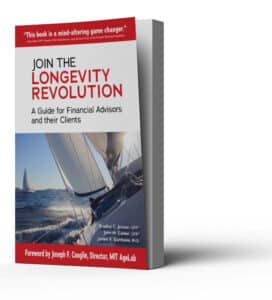Whether pursuing a traditional retirement or a nontraditional one that includes working for income later in life, your clients will need to make some important decisions to effectively answer the question, “How can I make my potential 100+ year life the most fulfilling it can be?”
Having talked with hundreds of retirees, we hear one consistent, clear message: Make sure your key choices are aligned with your core values.
While we can all name values we hold, the most important among them are core values.The word “core” has to do with the root of something. Core values are so deeply held that, together with your passion and purpose(s), they encompass your own personal “true north” for flourishing in the “Longevity Revolution.”
But what, exactly, is the Longevity Revolution?
First, it is a scientific revolution based on medical advances that will be coming fast and furious over the next decade, leading many, many more people to the 100+ year life. Second, it is a cultural revolution because these scientific advances call for deep reflection on each individual’s purpose and passion for living (and, likely, working) for a much longer time, core values for security and personal growth, health habits for supporting the coming scientific advances, and capacity to advance intergenerational relationships for a more fulfilling, longer life. Finally, it is a financial revolution because living healthier for longer necessarily requires more financial resources.
Clearly, core values can change over time because your way of being can shift over time.For example, some values you had when you were younger may be quite different from the values you have now; you may have let go of some values and adopted others as your life progressed.
Although identifying your client’s values for thriving later in life is essential for wise financial planning, many financial advisors bypass this important discussion and proceed directly to setting financial goals because they can more quickly and easily be attached to numbers, to amounts of money needed to reach them.
While identifying financial goals is certainly a necessary part of the planning process, that discussion should always follow a discussion about the core values that make your client’s life rewarding.
At the beginning of the millennium, Bill Bachrach published a book that underscores this point, “Values-Based Financial Planning: The Art of Creating an Inspiring Financial Strategy.” In Bachrach’s well-defined and helpful process, core values are revealed through a client-advisor conversation that begins with the question, “What’s important about money to you?” The client’s core values then lead to building a “values staircase” that fits well with Abraham Maslow’s original hierarchy of needs (that eventually became structured as a pyramid).
As the values conversation unfolds, the lower level of the values staircase (akin to thebase of the pyramid) deals with safety and security concerns (e.g., having enough money to pay the bills), the mid-level values deal with key relationships and activities, and the highest-level values deal with what Maslow himself described as self-actualizing values(e.g., “being the best person I can be,” or “making sure my life has purpose”). The core values identified through Values-Based Financial Planning can be called descriptive values, those that people already hold and that accurately describe what is important to them.
We will build on Bachrach’s work in two ways. First, we will offer an alternative to a hierarchical staircase or pyramid, and second, we will discuss prescriptive values, those needed for planning and thriving in a potential 100+ year life.
From Maslow’s pyramid to Kaufman’s sailboat
Dr. Scott Barry Kaufman, scientific director of the Imagination Institute at the University of Pennsylvania, in his book “Transcend: The New Science of Self-Actualization,” reimagined Maslow’s pyramid and offered a new image — a sailboat— thereby significantly advancing Maslow’s work.
Kaufman makes the point that life is not a trek up a summit where, once you arrive,you just stay, having fulfilled all your needs and desires once and for all. Human life just doesn’t work that way.
Instead, Kaufman envisions life more like a vast ocean of choices and experiences.This ocean is full of new opportunities for meaning and purpose, but it is also a journey in which we encounter stormy weather, with times of danger and uncertainty. As a result, a recurring need for safety and security can appear throughout the course of one’s life.
When one’s need for safety and security is threatened, it’s time to pause more enjoyable activities in order to “batten down the hatches.” In good times, with safety and security needs well taken care of, one can set sail for personal growth opportunities that lead to new experiences and a more fulfilling life.
 Connecting Kaufman’s sailboat image to core values, the hull of the sailboat might represent safety and security values, while the sail might represent growth values.The safety and security core values are those that allow for personal strength during the “stormy seas” of life. The growth core values are those that allow you to sail to new “ports of call” (i.e., new life experiences) in the future, as well as revisit familiar “ports of call” (i.e., favorite life experiences) again and again.
Connecting Kaufman’s sailboat image to core values, the hull of the sailboat might represent safety and security values, while the sail might represent growth values.The safety and security core values are those that allow for personal strength during the “stormy seas” of life. The growth core values are those that allow you to sail to new “ports of call” (i.e., new life experiences) in the future, as well as revisit familiar “ports of call” (i.e., favorite life experiences) again and again.
We believe the sailboat image is much stronger than a staircase or pyramid because the image of sailing on an ocean of choices and experiences better captures the vast possibilities and experiences in the over 12,700 days beyond age65 of your client’s potential 100+ year life. It also allows for the interplay of safety and security issues along with growth opportunities.
Again, when stormy seas make an appearance in someone’s life, their goals for flourishing may need to be postponed or altered to give sufficient energy and attention to their safety and security. On the other hand, when it’s smooth sailing,they might accomplish some goals faster than they thought, or they might add new goals.
They will want their “sailboat” headed in the direction of healthy transcendence or self-actualization in terms of peak experiences that involve, as Kaufman puts it, “heightened joy, serenity, beauty, and wonder.” Creating an excellent longevity plan based on their core values allows them to thrive in the Longevity Revolution.
Prescriptive core values for longevity
If your clients haven’t yet fully internalized the possibilities of the Longevity Revolution, the planning might be hit or miss when it comes to identifying and owning the core values needed to make the most of a much longer, healthier life. In truth, certain values are so important, so foundational, for the Longevity Revolution that if they don’t currently have these values among their personal core list, they will need to adopt them. For that reason, we label these prescriptive core values, those someone must have to join the Longevity Revolution.
Although millions embrace living a healthy lifestyle while they are young, the vast majority of people, unfortunately, do not have healthy longevity as a core value because their image of old age is not positive. They don’t yet perceive that they could personally benefit from the coming scientific advances that will help deliver the 100+ year healthy life.
Up to this point in their life, they might have even taken their health for granted. If so, it’s time to change that. If your client would not have previously listed “healthy longevity”among their core values, they need to do so now. By definition, they can’t join the Longevity Revolution without their health, and, although science can do a lot, science can’t do it all for them.
In addition to healthy longevity, your clients should be encouraged to embrace the importance of long-life learning, passion for their purpose(s), and creativity and exploration. However, there are two more core values we have not yet mentioned that qualify as necessary or prescriptive for flourishing longevity.
Personal happiness is key core value
First, their list must include the value of personal happiness. In fact, happiness is so important for human flourishing that it has been written about since the time ofthe earliest Greek philosophers, including Aristotle (384–322 B.C., who considered happiness the goal of human thought and action.)
Fast forwarding in time. In recent decades, happiness has become the subject of scientific study. Martin Seligman, professor of psychology and one of the most prominent researchers on happiness, wrote “Flourish: A Visionary New Understanding of Happiness and Well Being,” that uses interactive exercises aimed at growing personal happiness.
Whereas happiness is so important that we consider it a universal core value forlongevity planning, the “pursuit of happiness” can be easily misunderstood as nothing more than pleasure-seeking behavior or having a constant state of intense positive emotions. To be sure, happiness has an emotional impact, but it doesn’t have to be understood in terms of a constant feeling of joy. Dr. Ed Diener and his son Dr. Robert Biswas-Diener provide helpful clarification on happiness:
“We recommend that people think of happiness in terms of mildly pleasant emotions that are felt most of the time, with the intense positive emotions being felt occasionally. If you feel fairly energetic and upbeat most of the time on most days,and are generally satisfied with your life with only the occasional complaint, you are,by our definition, happy. Some of us will feel more intense emotions and some of us less intense emotions due to our different temperaments, but frequent positive emotions should be the goal, rather than continuing intense feelings.”1
Another researcher doing innovative work on happiness is Dan Buettner, who joins happiness and longevity in a powerful way. Buettner’s research on longevity goes back over 20 years and led to his creating Blue Zones, a company that helps people live longer, happier lives. As Buettner explains, Blue Zones are areas in the world that havea relatively high percentage of healthy centenarians.
In 2017, he published “The Blue Zones of Happiness: Lessons from the World’s Happiest People,” which includes specific strategies involving community, work, home, and self.Together, the strategies result in happiness-boosting habits. As the late motivational speaker Jim Rohn once said, “Happiness is not by accident.”
On the contrary, happiness is on purpose. Because happiness is on purpose, we want you to know that you can help clients plan for it. That is why we want you to make happiness a core life value and integrate a personal pursuit of happiness into your client’s longevity plan.
Growth mindset: the meta-value
The last fundamental core value for longevity planning is having a growth mindset (or attitude). Of all the core values, this is the one meta-value that encompasses all the other prescriptive longevity core values: growth in healthy longevity, growth in long-life learning,growth in the ability to explore, growth in creativity and exploration, growth in purpose(s) and passion, and growth in happiness.
Having a growth mindset means that rather than these areas being stuck or set, your client truly believes they can enhance, add to, or change them by having a positive “can-do” attitude about their ability to do so. A growth mindset puts someone in control of making their 100+ year life the most fulfilling it can be.
The innovative Modern Elder Academy showcases the importance of having a growth mindset later in life using the work of Dr. Carol Dweck, professor of psychology at Stanford University. Her work illustrates the power of our most basic beliefs, those that make up our “mindset.” Whether conscious or subconscious, these beliefs affect both what we want and whether we succeed in getting it. In short, our mindset either propels us toward or prevents us from achieving our potential as it relates to longevity planning.
Applying Dweck’s work to values, if someone believes that their core values are unchangeable at this stage of their life or that they cannot add to or grow new core values moving forward, then they have a fixed mindset vis-à-vis their values. That fixed mindset will be a self-fulfilling prophecy: They won’t grow because they think they can’t grow. Therefore, if they think their core values are set in stone at this stage of their life, guess what? They’re right. For them, they are fixed.
But if they adopt a growth mindset and believe core values are flexible and changeable, they’re right, too! For them, they are flexible and changeable! In the spirit of juvenescence, someone can adapt their life to the values needed for joining the Longevity Revolution.
Prescriptive core values are all growth values
Keep in mind that the prescriptive core values for the Longevity Revolution (listed below) are all growth values, the “sail” of the sailboat.
- Healthy longevity
- Long-life learning
- Creativity and exploration
- Passion for your purpose(s)
- Happiness
- Growth mindset
One prescriptive core value that relates to safety and security, the “hull” of your boat: sufficient financial resources for the 100+ year life. As their financial advisor, you can help your clients identify sufficient financial resources to help meet your goals for your potential 100+ year life.
Descriptive core values
Of course, the prescriptive core values for longevity are not the only important core values someone holds. We focused on prescriptive core values first because they are essential in the Longevity Revolution. As we mentioned earlier, there are also important descriptive core values, values that you have internalized and may have been functioning in your life for decades.
These are the values that have given your client’s life direction down to the present day. They are values they may have internalized from their childhood experiences,their family, their education, their place of worship, their work, their friends, and their life experiences.
They include values such as marriage, family, friendship, faith, integrity, compassion,etc. They likely already know what these descriptive core values are and how they function in their life, even if they haven’t ever formally named or listed them.
1 Ed Diener and Robert Biswas-Diener, “Happiness: Unlocking the Mysteries of Psychological Wealth” (Malden, MA: Blackwell Publishing, 2008), 216.
This article is an excerpt from the book, “Join The Longevity Revolution: A Guide for Financial Advisors and Their Clients,” written by Bradley C. Jensen, John M. Comer and James V. Gambone.
Bradley C. Jenson, CFP, CIMA, AIF, CAP, is a financial advisor with Lake Superior Financial Services in Duluth, Minn., and a member of the Investments & Wealth Institute,the Financial Planning Association, the MIT AgeLab’s PLAN network, and the ModernElder Academy. John M. Comer, CFP, is a financial advisor with McNellis & Asato in Bloomington, Minn., and member of the Financial Planning Association, and MIT AgeLab’s PLAN network. James V. Gambone, Ph.D., is a generational and intergenerational expert and author of “ReFire Your Life. Any opinions are those of the authors and not necessarily those of Raymond James Financial Services or Raymond James.







